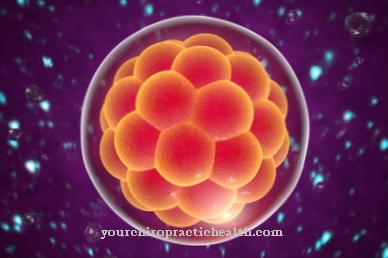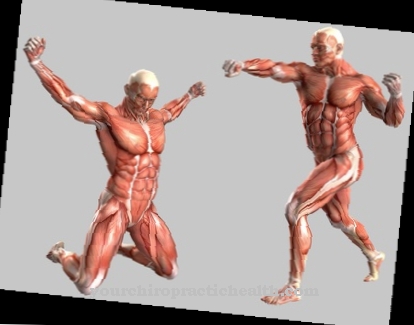A Easy breathing is a regulatory measure of the body to avoid pain. It leads to reduced performance and can lead to serious complications.
What is gentle breathing?

Gentle breathing is characterized by the fact that the breathing depth is reduced in order to avoid aggravated pain due to the expansion of the chest. The triggering pain can have various causes.
The shallow breaths cause the tidal volume to be reduced. Normally, it is an average of 500 ml at rest. Together with the resting frequency of 12-15 breaths / minute, this results in a minute volume of around 7.5 liters.
The reduction in the depth of breath means that the lungs are poorly ventilated, and insufficient oxygen-saturated air can reach the alveoli. The gas exchange that takes place there is reduced and the oxygen saturation in the blood drops, which has a direct impact on performance.
In contrast to shallow breathing due to mechanical causes, the possibility of compensation by increasing the frequency is no longer possible in the case of non-breathing because it is pain-related. Reduced ventilation, also known as hypoventilation, provides good conditions for pathogens to penetrate into the lungs, especially for pneumococci.
Function & task
The task of gentle breathing is to avoid pain that can arise or be aggravated by the expansion of the chest or abdomen when breathing in. The causes of pain can be varied. During inhalation, the thorax is dilated at rest by using the diaphragm and the intercostal muscles. The outside of the lungs is covered with a thin skin, the pleura (pleura visceralis), which is connected to the pleura (pleura parietalis), which lines the chest inside. In the gap in between there is liquid that makes the two skins stick together. Due to this construction, the lungs are drawn and widened with the expansion of the thorax and air can flow into them from outside. This reaches into the smallest units, the alveoli, in which the gas exchange takes place.
When breathing gently, the expansion of the thorax is reduced. The alveoli are only partially expanded or not at all. No or too little fresh, oxygen-enriched air gets there. The absorption of O2 into the blood is reduced and with it the supply of the cells. The people affected have to reduce their activities, their performance drops.
In this case, the regulatory mechanisms that control the systems prioritize avoiding pain, to the detriment of the oxygen supply to the organs and cells. Compensation mechanisms such as the increase in frequency, which are otherwise set in motion with shallow breathing, are suppressed.
The respiratory center in the elongated spinal cord (medulla oblongata) normally regulates breathing based on the oxygen and carbon dioxide levels in the blood, which are measured by certain receptors. The breathing is adjusted as required so that these values remain constant within narrow limits. The pain that is the cause of the easy breathing breaks this mechanism. The inhalation muscles are inhibited in order to keep the intensity of their activity low, although this changes the blood composition unfavorably, the oxygen content drops and the carbon dioxide content rises.
You can find your medication here
➔ Medication for shortness of breath and lung problemsIllnesses & ailments
The causes of non-breathing can be illnesses, injuries or operations on the lungs, the surrounding tissue, the chest or the abdomen. Inflammation of the lungs (pneumonia) or bronchitis cause pain in the lungs, which increases as the lungs expand. While pneumonia is a typical bacterial disease (pneumococci), viruses are most often the cause of bronchitis.
Inflammatory irritation of the two pleurae, known as pleurisy, is extremely painful. They often occur as a result of chest injuries in the form of mechanical irritation, less often as a result of secondary bacterial infestation. If the affected regions are locally limited, it is possible to compensate for the restrained breathing by directing the breath by breathing more intensely into other unaffected areas.
Traumas in the chest area are also very painful and can affect breathing in the long term. This includes broken ribs as well as bruises in the ribs and thorax, the impairment of breathing depending on the size of the affected area and the type of injury. Fractures of a single rib only slightly restrict the ability to breathe in contrast to rib fractures. Fractures in which the ends of the fracture are pressed against the lungs and the lung membrane during breathing movements and can pierce them are particularly dangerous and impairing. Chest bruises often have a long-term negative impact on breathing. Good pain management is particularly important in this case to avoid complications.
Abdominal pain caused by temporary discomfort can be compensated by shifting the direction of breathing and does not lead to sustained non-breathing. Abdominal breathing is avoided in this case and chest and flank breathing are increased.
All operations that are performed in the areas affected by the expansion while breathing can lead to breathing sparingly, as the operation area and the scars are painfully stretched by the expansion. These include lung operations as well as open heart and abdominal interventions.
As a result of non-breathing itself, complications related to hypoventalation and changes in blood composition can occur. The poor ventilation of the lungs makes pneumococci easy to invade the lung tissue and pneumonia can develop. Pneumonia can therefore be both a cause and a consequence of not breathing. The change in the pH value in the blood as a result of the disturbed gas exchange increases the risk of thrombosis and the associated risk of pulmonary embolism.



























